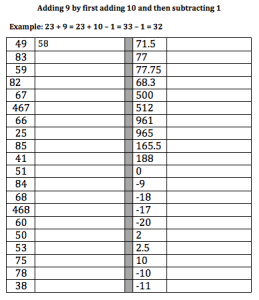In my ninth grade Numeracy course, I have been following the Transition to Algebra curriculum while supplementing with other resources and ideas.
One of the tenants of this curriculum is to begin each day with 5 minutes of Mental Mathematics. For each unit, there are generally 13 Mental Math activities suggested in the back of the teacher unit materials that “help students build working memory so that they can keep multiple pieces of mathematical information at once.”
In their guide, they suggest that the Mental Math activities be carried out verbally and in unison. I recently went to a TTA PD at New Visions and asked the facilitator why they promote verbal call and response rather than written. I explained that when I tried this in my classroom, I felt that my 24 students started falling into a heiarchy of verbal mental math where about 6 of them (1/4) were regularly participating. She suggested that I use wait time, which I had, and also explained that their intention was for students to learn from one another and that the teacher should adapt to where the students are, on a whole, getting stuck and retrace their steps back to that place so that more students can participate.
An example of an activity would be “Adding 9.” The first step in the Mental Math activity this day is to add 10, where the teacher would say “23” and the students, in unison, would say “33.” Then, step 2 is to is to bridge to Adding 9- “Adding 9 is adding 1 less than adding 10.” So the teacher would say “25” and the students, in unison, would say “34.”
My modification has been a verbal call and response launch to the activity (today with guest speaker Jason)
And then a written worksheet that they work on independently:
I circulate as they work and if a student seems “stuck” or is continuously making an error, I will re-engage them by repeating the strategy from the video and doing a mini verbal mental math with them.
In order to have been programmed for my Numeracy course, the students must have scored a 1 or a 2 on the 7th and 8th grade New York State math assessments (out of 4 points) and have traditionally struggled with math. I want my room to be a place where they can feel successful at math and struggled to balance that with the verbal Mental Math practices, where the 18 students who were not verbally engaged felt “less than” the 6 who were. I also do not want my classroom to be a place where the students who are “quicker” at mental math are “better.” That said, I want to find ways other than call and response to use verbal mental math in my classroom.
I am interested in incorporating Number Talks and Counting Circles and Number Strings into our mental math rotation this semester. What I like about the Counting Circles is that there is a pattern and a way for the students to “ready” themselves compared to the Mental Math call and response.
